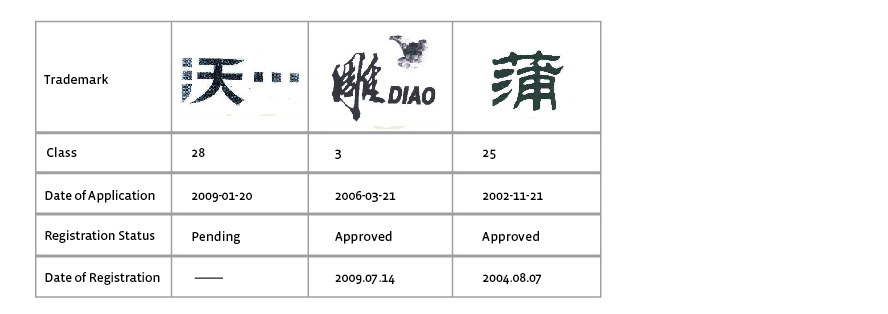

When encountering a brand logo, what catches your eye first? Colors, images, or the name? Scientific studies reveal that the brain processes shapes before colors and content. This holistic recognition is encapsulated in the trademark, also known as the brandmark, logo, or symbol. In the realm of branding, especially in the context of China, the significance of single character Chinese trademarks becomes evident. These concise characters not only serve as powerful symbols but also align with the cognitive patterns identified in branding studies. Explore the impact and uniqueness of single-character Chinese trademarks as we delve into the science and artistry behind shaping consumer perceptions in the dynamic Chinese market.
An important aspect of the trademark is the brand name itself. We have selected three companies whose name and trademark consist of only one single Chinese character, “沃” (wò) , “蒲” (pú), and “雕” (diāo). One character names are very rare—most Chinese names will be 2, 3, 4, or more characters. (We’ve even seen up to seven characters long!) As one character names are rare and fascinating, this article aims to uncover whether they could be a favorable choice as a potential branding solution. Firstly, we will examine the meaning of the three names and try to evaluate whether they are effective in appealing to their target markets or not. We will then analyze the benefits and risks of using a single character trademark as a brand name.

沃wò
Over the past year, China Unicom created a new trademark: “沃wò”, to be used for their new series of technical services and products such as 3G. In addition to functioning as a brand name, the unique trademark itself has served to increase brand awareness. According to the Chinese dictionary, the adjective “沃” means fertile, abundant, and rich. Furthermore, the pronunciation “wò” is significant, as it is used to convey surprise or a strong impression. Thus, the meaning of the Chinese character provides a promise to customers that their business is diverse and colorful; meanwhile their range of services is comprehensive. In addition, the logo is said to be one part of a red Chinese knot, which connects it to the original China Unicom visual identity. At first sight, consumers are supposed to get the sense that China Unicom is an energetic, dynamic and innovative Chinese brand.

PUKKA 蒲
The brand “PUKKA蒲” belongs to the garment industry. Its trademark includes two parts: the Chinese name, 蒲[pú], and the English name, Pukka. “蒲” is a kind of herb containing a fiber which can be used to make fabric, thereby expressing that Pukka’s fabrics are made from natural fibers, an important attribute of the brand. The single character has special significance because “蒲” is used in a Chinese traditional anthology of poems, named “诗经” (Shijing), where it means herb and is used to describe beautiful and natural scenery. Furthermore, this Chinese character stands for good luck, making it attractive for Chinese consumers.
The name “Pukka” originally means solid and good quality, although this use is not well known. Through its English name, the brand is trying to express that their products are of the best quality and offer a natural and elegant lifestyle. Additionally, the pronunciation of the Chinese character is similar to its English name, thereby connecting the two verbal identities.

雕[diāo]
The brand “雕” [diāo] produces washing powder. Washing powder is a consumable, which means consumers purchase the product often and easily understand it. Some may think that there is no need for branding of this kind of product; however, there are many competitors on the washing powder market, and thus it is necessary for the brands to differentiate themselves. Choosing a unique and striking name can be an effective strategy for this type of brand, which is what 雕[diāo] has done.
Firstly, regarding the pronunciation, “diāo” is a very special and rare sound in the Chinese language. Secondly, the meaning of this character is easily understood—it stands for a large eagle. Thus, this character conveys the feeling that the brand will protect customers from external enemies, in this case, dirt or things that can stain clothing. The single character name, the rare pronunciation, and the meaning all serve to differentiate this brand from others.
After giving an introduction to these three single Chinese character trademarks, we are now going to analyze single character names and trademarks in general, identifying both the pros and cons of using this type of trademark.
Easy to read and remember: Being easy to read and remember are the foremost characteristics any trademark aspires to, which is easier for single character trademark to obtain. In addition, the single character trademark will be easy to recognize, understand, and communicate.
Expressiveness: The more differentiating a trademark is, the more stimulating it can be for consumers. In contrast with countless two or three character names, single character names are prone to express attributes in a more focused and penetrating way, thus leaving a greater impression on consumers.
Difficulty of registration: Single character Chinese trademarks have a low possibility of being registered due to the difficulty of proving the name is different enough from other existing trademarks that contain the same character. The trademark cannot be registered unless it is proved to be different enough according to all three of the following aspects: sound, meaning, and graphics. This makes single character names much more difficult to register than two or three character names.
Risk of misunderstanding: If a person does not see the trademark, but only hears the brand name, he or she can easily think that 蒲[pú] is actually 普[pǔ], for example, which means “general and common”. And they may also mistake “沃wò” for another similar character, and then totally misunderstand the brand message and positioning.
Narrowness of brand scope: Single character names are usually attached to one single product or service, rather than to a general brand. More brand communication efforts will be required for one character brand names in order to help broaden the perception of the name of the product or service.
As always, the effectiveness of any given brand name comes down to the brand’s target market. Let’s take “PUKKA蒲” for example. While the brand name is appealing for modern white-collar consumer groups, it may not be able to attract teenagers or elder women at the same time. Furthermore, since its name implies a natural and elegant life style, the brand cannot move into sports clothing or high fashion industries. Overall, even though Pukka’s single character name is differentiating, expressive, and attractive for a given target market, the name itself could limit the brand’s future development and diversification.
Instead of using a standard format, all three brand names discussed here have been registered in a special font, or with other marks or verbal elements included in their trademark. If they did not do so, it would be unlikely that these single character names could be approved as they would not be different enough from other names.
Please see the table below for more details.

In conclusion, we can say that adopting a single character name and trademark can turn out to be an effective strategy for some brands. However, a brand must take a number of considerations into account, such as their target market, brand positioning, the future development of the brand, and registration constraints before choosing this unique naming option.
1 Wheeler, A. (2006). Designing Brand Identity. Hoboken, NJ: John Wiley & Sons.
A Labbrand Group Company © 2005-2025 Labbrand All rights reserved
沪ICP备17001253号-3To improve your experience, we use cookies to provide social media features, offer you content that targets your particular interests, and analyse the performance of our advertising campaigns. By clicking on “Accept” you consent to all cookies. You also have the option to click “Reject” to limit the use of certain types of cookies. Please be aware that rejecting cookies may affect your website browsing experience and limit the use of some personalised features.